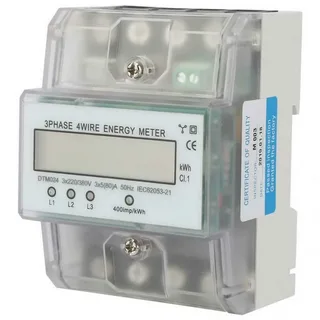5 Benefits of Using a Digital Electric Meter

Strong 8k brings an ultra-HD IPTV experience to your living room and your pocket.
In an age where precision, efficiency, and smart technology drive our daily lives, the digital electric meter stands at the forefront of energy management. These modern tools have revolutionized the way we measure, manage, and optimize electricity consumption, replacing outdated analog systems with intelligent, data-driven solutions.
Whether in a household, an industrial complex, or a government facility, digital electric meters are vital to ensuring energy efficiency, reducing costs, and promoting sustainable power usage.
2. What is a Digital Electric Meter?
A digital electric meter is an electronic device that measures the amount of electrical energy consumed by a residence, business, or an electrically powered device. Unlike analog meters, which rely on mechanical parts, digital meters use microcontrollers and sensors to provide precise readings.
Key Characteristics:
LCD/LED display for easy reading
High accuracy and low error margin
Data logging and storage capabilities
Remote communication features
3. History and Evolution
The journey of metering devices spans over a century:
Late 1800s: Introduction of electromechanical meters using spinning disks.
Mid-1900s: Analog meters dominate households.
1980s - 1990s: Advent of digital display meters.
2000s: Integration with remote communication tools.
Today: Smart digital meters with IoT and AI capabilities.
4. Working Principle of a Digital Electric Meter
Digital meters measure electricity in kilowatt-hours (kWh) using current transformers and voltage sensors. They sample voltage and current many times per second and multiply these values to calculate real-time power usage.
Steps in Measurement:
Current and voltage sensors collect data.
Analog signals are converted to digital.
Microcontroller processes the information.
Data is displayed and transmitted.
5. Types of Digital Electric Meters
Based on Application:
Single-phase meters: Used in homes and small offices.
Three-phase meters: Found in industrial and large commercial settings.
Based on Functionality:
Static Meters: Measure energy based on electronic principles without any moving parts.
Prepaid Meters: Allow consumers to pay in advance.
Smart Meters: Enable two-way communication for real-time updates.
6. Key Components of Digital Electric Meters
LCD/LED Display
Microcontroller Unit (MCU)
Voltage and Current Sensors
Non-volatile Memory (for data logging)
Communication Modules (e.g., Wi-Fi, ZigBee, RF, GSM)
Power Supply Unit
7. Benefits of Using a Digital Electric Meter
1. Accuracy and Reliability
Removes errors common in manual reading.
Offers consistent performance over time.
2. Real-Time Monitoring
Consumers can monitor their usage instantly.
Enables energy-saving strategies.
3. Smart Billing
Eliminates estimated billing issues.
Accurate billing based on exact usage.
4. Remote Accessibility
Utility companies can collect data remotely.
Enables remote disconnections and reconnections.
5. Environmental Benefits
Promotes energy conservation.
Reduces the carbon footprint.
8. Digital vs Analog Electric Meters
Feature
Digital Electric Meter
Analog Electric Meter
Accuracy
High
Moderate
Data Logging
Yes
No
Remote Monitoring
Yes
No
Display
LCD/LED
Mechanical dials
Maintenance
Low
Higher
Tamper Detection
Yes
No
9. Smart Digital Meters and IoT Integration
The newest generation of digital meters is "smart" — interconnected devices that can:
Integrate with smart home systems
Provide mobile alerts
Support demand-response programs
Offer usage analytics via apps
Help utilities manage load distribution dynamically
10. Applications in Residential, Commercial, and Industrial Settings
Residential
Energy usage alerts
Cost-saving analytics
Load limit features
Commercial
Sub-metering for different departments
Peak demand tracking
Integration with Building Management Systems (BMS)
Industrial
Large-scale consumption monitoring
Harmonic analysis and power factor correction
Automated load control
11. Challenges and Limitations
Despite the advantages, digital electric meters have a few hurdles:
High Initial Cost
Cybersecurity Threats
Privacy Concerns
Technical Literacy Requirement
Data Misinterpretation Risks
12. Future Trends in Digital Metering
AI and Machine Learning: Predict usage patterns and optimize energy distribution
Blockchain in Energy Transactions: Enable peer-to-peer energy trading
Advanced Data Analytics: Provide detailed consumption breakdowns
5G Connectivity: Faster and more reliable data transfer
Green IoT: Enhance sustainability and reduce e-waste
13. How to Read a Digital Electric Meter
Steps:
Locate the meter’s LCD screen.
Identify key metrics (kWh, voltage, current).
Some meters cycle through various values.
Note down the reading for comparison.
Use apps (if available) for detailed analysis.
14. Installation and Maintenance Tips
Installation Guidelines:
Choose a dry, ventilated location
Ensure stable voltage supply
Hire licensed electricians
Avoid exposure to sunlight and water
Maintenance Tips:
Periodic inspection every 12 months
Check firmware updates for smart meters
Clear dust and debris around the meter box
Regular data downloads for logging
15. Government Policies and Smart Meter Rollouts
Many countries are pushing smart metering as part of their energy reforms:
India: Plans for 250 million smart meters by 2030 under the RDSS scheme
USA: Widespread rollout supported by state-level mandates
UK: Nationwide smart meter implementation for homes and small businesses
EU: Smart meter target coverage of 80% by member states by 2025
16. Top Brands in the Digital Meter Market
Some of the leading manufacturers globally include:
Schneider Electric
Siemens
Landis+Gyr
Itron
ABB
General Electric (GE)
Elster
Secure Meters
Iskraemeco
Hexing Electrical
17. Frequently Asked Questions (FAQs)
Q1: Are digital electric meters accurate?
Yes, they are significantly more accurate than analog meters and come with self-calibration features.
Q2: Can digital meters detect power theft?
Many advanced digital meters have tamper detection features that notify utilities of unauthorized access or bypassing attempts.
Q3: Is it safe to install a digital meter at home?
Absolutely. When installed by licensed professionals, digital meters pose no electrical risk and often enhance safety.
Q4: How do I check my digital meter remotely?
If your meter is smart-enabled, you can use associated mobile apps or web portals to track consumption.
Q5: What is the lifespan of a digital electric meter?
Typically ranges from 10 to 20 years with minimal maintenance.
18. Conclusion
The digital electric meter is not just a tool—it is a gateway to smarter energy usage, real-time data, and efficient resource management. As nations push for sustainability and consumers grow more energy-conscious, digital meters will be indispensable.
Note: IndiBlogHub features both user-submitted and editorial content. We do not verify third-party contributions. Read our Disclaimer and Privacy Policyfor details.


